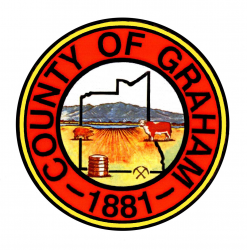Graham County


Graham County, formed in 1881 by the 11th Territorial Legislature, was created from parts of Apache and Pima counties. The legislature broke with tradition of naming Arizona counties after local Native American tribes when the new county called Graham was named after the 10,724 foot Mount Graham, the highest peak in the area. The mountain in turn had been named Graham after Lieutenant Colonel James Duncan Graham, a senior officer in the Brig. General Stephen W. Kearney's U.S. Army Corps of Topographical Engineers.
The history of the area has three major themes.
Graham County is in Southeast Arizona. The terrain is mostly composed of high desert plains at the base of medium to large basalt mountains. This area is rather unique for Arizona, since it actually has a small river running through its major valley all year round. And since most of the land here is on the edges between the mountains and the high desert plains we are in what is known as a transition area between two major biomes.
A biome is a particular terrain, climate, elevation combination which has a particular array of plant and animal life. In the areas known as transitions, the plant and the animal life of both biomes abound. Graham County is one of the areas with the widest variety of animal and bird life of any area in the United States. This is also the site of the only two designated Riparian Areas in the United States. A Riparian area is that area near running water that supports water loving plants, water birds and amphibians. Yes, Graham County has that much water. We have the Gila River, the Bonita Creek, and underneath the land flows mineral water springs, artesian wells, and even some potable fresh water.

Graham County, formed in 1881 by the 11th Territorial Legislature, was created from parts of Apache and Pima counties. The legislature broke with tradition of naming Arizona counties after local Native American tribes when the new county called Graham was named after the 10,724 foot Mount Graham, the highest peak in the area. The mountain in turn had been named Graham after Lieutenant Colonel James Duncan Graham, a senior officer in the Brig. General Stephen W. Kearney's U.S. Army Corps of Topographical Engineers.
The history of the area has three major themes.
Graham County is in Southeast Arizona. The terrain is mostly composed of high desert plains at the base of medium to large basalt mountains. This area is rather unique for Arizona, since it actually has a small river running through its major valley all year round. And since most of the land here is on the edges between the mountains and the high desert plains we are in what is known as a transition area between two major biomes.
A biome is a particular terrain, climate, elevation combination which has a particular array of plant and animal life. In the areas known as transitions, the plant and the animal life of both biomes abound. Graham County is one of the areas with the widest variety of animal and bird life of any area in the United States. This is also the site of the only two designated Riparian Areas in the United States. A Riparian area is that area near running water that supports water loving plants, water birds and amphibians. Yes, Graham County has that much water. We have the Gila River, the Bonita Creek, and underneath the land flows mineral water springs, artesian wells, and even some potable fresh water.